Summary of Rogier van der Weyden
Rogier van der Weyden was one of the most significant and influential artists of the Flemish Northern Renaissance, along with Jan van Eyck and Robert Campin. He became the official painter of the city of Brussels, and made work for the Duke of Burgundy, ruler of the region at the time. The figure groups and compositions for portraits and Biblical scenes that Van der Weyden devised inspired generations of later artists, and his ability to represent intense emotions was recognized as one of his signature contributions to European art.
Like his contemporaries, he emphasized close observation and meticulously detailed representation, balancing this illusionistic realism with an equal interest in strong, linear surface design. Although none of the existing works ascribed to him is signed, his distinctive style, combined with recent detailed technical examinations and numerous documents identified by scholars, has enabled art historians to assemble a coherent - if often debated - body of work by him. Dirk de Vos in his catalogue raisonné on the artist counted thirty-six surviving works and about forty that have been lost, noting that care must be taken to distinguish Van der Weyden's hand from those of his workshop assistants.
Accomplishments
- Van der Weyden's greatest impact may have been in the depiction of emotions. He is credited as the first European artist to paint figures visibly weeping, and the powerful visual effect of his carefully orchestrated compositions, with figures often placed in shallow spaces that seem to extend toward the viewer, heightens the impact of the emotions those figures express. As Michelangelo is said to have commented almost a hundred years later, perhaps with Van der Weyden in mind, "Flemish painting... will please the devout better than any painting of Italy, which will never cause him to shed a tear, whereas that of Flanders will cause him to shed many."
- His compositions were highly influential, thanks in part to the standard workshop practices of the time, which often involved literally reusing the same drawn pattern in different works. He is also said to have developed the format of the devotional portrait diptych, in which a sitter in prayer faces a depiction usually of the Virgin and Child, a format that other artists also replicated.
- Like many of his contemporaries, Van der Weyden often incorporated illusionistic elements in his paintings, exploring the boundaries between three-dimensional sculptures and structures and the flat surface but life-like colors of painting. Where Jan van Eyck included a mirror in some of his works, to imply the viewer's presence in front of the painting, Van der Weyden surrounded several of his images with painted frames, which the figures in the scene often touched or overlapped, suggesting that the painted scene extended outward beyond the frame. His intention was to enable the viewer to experience the image in a more immediate way, as if it were occurring in the viewer's own space and time.
The Life of Rogier van der Weyden
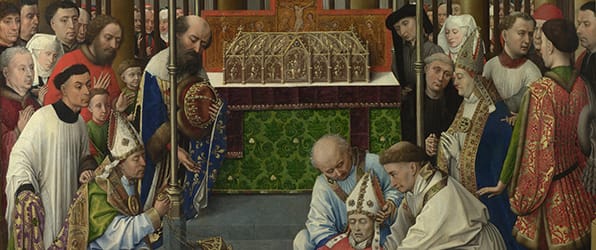
Rogier van der Weyden is credited as the first European artist to paint visible tears on weeping figures. He enjoyed a great deal of success and acclaim during his life; though he didn’t let this get to his head, and engaged in philanthropic pursuits instead of merely reveling in the lavish lifestyle he certainly was able to afford.
Important Art by Rogier van der Weyden
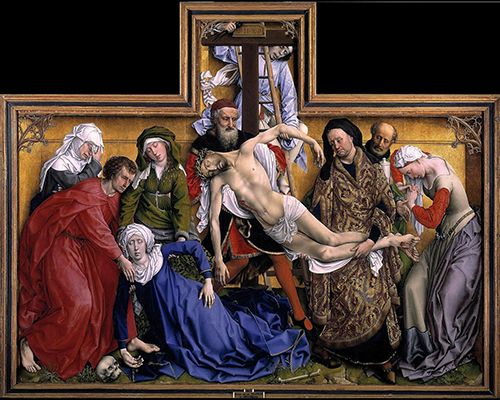
Descent from the Cross
Considered to be Van der Weyden's masterpiece, Descent from the Cross depicts the crucified Christ being lowered from the cross by Joseph of Arimathea and Nicodemus. Packed into the shallow composition are several other figures, including Mary Cleophas, John the Evangelist, Mary Salome, the Virgin Mary, and Mary Magdalene. The work was probably commissioned by the Leuven guild of crossbowmen for their chapel Onze-Lieve-Vrouw-van-Ginderbuiten (Our Lady Outside the Walls). Later, Mary of Hungary, governess of the Netherlands, installed it at her castle in Binche, south of Brussels, and the painting was then acquired by her nephew, King Philip II of Spain, from whose collection it was eventually placed in the Prado museum.
This work was created in the same period that Van der Weyden was completing his apprenticeship with Robert Campin, whose influence can be felt, for instance, in the hard surfaces, precise details, and taut linearity of the figures. Indeed, there is a fragment depicting the Bad Thief (Städelsches Kunstinstitut, Frankfurt) that once belonged to a large Descent from the Cross triptych and is usually attributed to Campin or the Master of Flémalle, that bears striking stylistic similarities to Rogier's panel. This underscores the exchange of ideas and techniques that occurred in the workshop context.
All the elements of this painting are intended to affect the viewer in an immediate, viscerally emotional way. This includes the gestures and expressions of grief each of the figures displays and the parallels between Mary's body as she swoons and the lifeless body of her son. These details exemplify the concept of the "imitation of Christ" central to the Modern Devotion movement of the period that encouraged followers to feel and identify directly with Christ's suffering. Even the tightly compressed space and spatial and conceptual ambiguities in the image enhance the immediacy and presence of the figures. Art historian Dirk de Vos suggests that Van der Weyden aimed to evoke two ideas simultaneously, of a life sized, carved altarpiece with polychromed figures, its corners filled with carved, gilded tracery, and of a tableau vivant with living actors on an illusionistic stage. Art historian Lorne Campbell asserts that the composition was meant to create a sense of unease in the viewer, as evidenced by such details as the way the ladder appears behind the cross at the top, and in front of it at the bottom.
The Descent from the Cross also had an immediate impact on other artists, many of whom in subsequent years emulated or directly copied the composition or its figures. The first copy, known as the Edelheere triptych (Museum M, Leuven), was made by an unknown artist as early as 1435, and de Vos lists fifteen other existing versions or interpretations in paintings and prints, among only the most important examples.
Oil on oak panel - Museo del Prado, Madrid
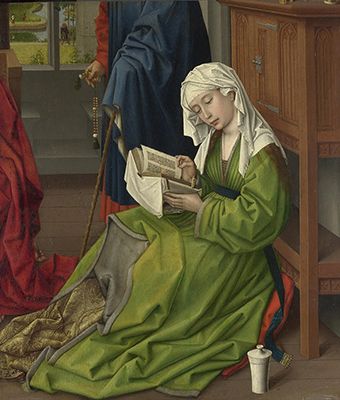
The Magdalen Reading
This work is one of three surviving fragments of a large altarpiece that probably depicted the Virgin and Child with Saints, as evidenced by a later drawing that seems to record a more complete portion of the altarpiece. The Magdalen would have been in the lower right corner of the composition, flanking the seated Virgin and child. Most scholars consider this an early work of the mid-1430s, when Rogier’s connections with Robert Campin may still have been close.
Mary Magdalene is accompanied by her characteristic attribute, the jar of ointment with which she is said to have anointed Christ's feet. She is richly dressed in a fur-lined overdress and a cloth of gold underdress, and reads a volume, probably a Bible, held in a cloth cover used to protect valuable books. Mary's absorption in her reading indicates her pious devotion. The two partially visible figures beside her are most likely Saint John the Evangelist in red, kneeling before the Christ Child, and Saint Joseph in a blue cloak, standing behind the Magdalene.
Van der Weyden executed this painting with a remarkable level of detail, including the jewels adorning the hem of Mary's dress, the legible letters in her book, and the tiny figures in the distant landscape outside the window. Mary's elegant and slightly stylized and simplified features and hands are also characteristic of Rogier's work, although some writers find other aspects of the painting, such as the cabinet and the floor, to be less skillfully handled, indicating that they may have been painted by Rogier's assistants.
Oil on mahogany - The National Gallery, London
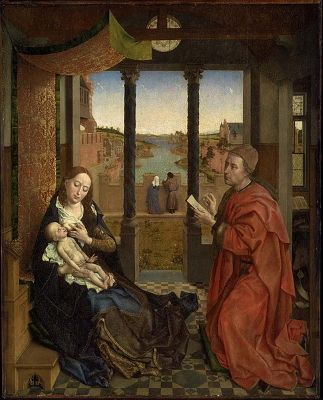
Saint Luke Drawing the Virgin
Although the condition of this painting has deteriorated, it is one of Van der Weyden's most significant works, probably painted for the Brussels guild of painters - whose patron saint was Luke - in just the period when Van der Weyden moved to that city. The Gospel of Saint Luke covered Mary's life in some detail and therefore the saint came to be considered the first to portray her. This work may be the earliest known example to depict Saint Luke creating a portrait in the presence of his sacred models. He is shown kneeling before the Virgin and Child in a richly appointed room, drawing with a metalpoint on a small sheet; beyond them is an enclosed garden, which alludes to Mary's virginity, and two small figures looking out over a parapet at the river lined with urban buildings. The scene underscores the humble, earthly nature of the figures; Mary has no halo or crown, but sits at the foot of the throne, embodying her humility, and breastfeeds the child to highlight their physical connection. The cityscape in the background consists of typical Flemish buildings, suggesting that the scene takes place in surroundings like the viewer's own.
Saint Luke is compositionally very similar to Jan van Eyck's Madonna of Chancellor Rolin (c. 1435, Musée du Louvre, Paris), which was completed in virtually the same period. Presumably, Van der Weyden could have seen Van Eyck's panel in Bruges, before it was sent to Autun in Burgundy, Chancellor Rolin's hometown. Both scenes take place in similarly elegant rooms with tiled floors, tripartite doorways, and two background figures observing a river view. The similarities point to both the inspiration that Rogier seems to have drawn from Van Eyck's work and the innumerable variations he introduced to arrive at his own original composition.
The probable initial location of Van der Weyden's painting in the Brussels painters' guildhouse, or in their chapel in the Cathedral of Saint Gudule (where Van der Weyden was later buried) may account for the three close copies of the work (now in the Hermitage, Saint Petersburg; the Alte Pinakothek, Munich; and the Groenigemuseum, Bruges) that were made in later decades, as well as numerous repetitions or interpretations of individual figures, particularly that of the Madonna and Child. One example of a direct copy of the background cityscape and the two figures observing it can be found in a painting that dates to about 1500 by an unknown Brussels artist labelled the Master of the Embroidered Foliage (Clark Art Institute, Williamstown, MA), demonstrating the long-lasting popularity of Rogier's composition and the persistence of workshop patterns and practices. The Boston Saint Luke is also likely to have been the work that Albrecht Dürer described as a "Sanct Lucas Tafel" (Saint Luke panel) when he saw it on his 1520 visit to Brussels, further demonstrating the international renown of the painting.
Oil and tempera on oak panel - Museum of Fine Arts, Boston
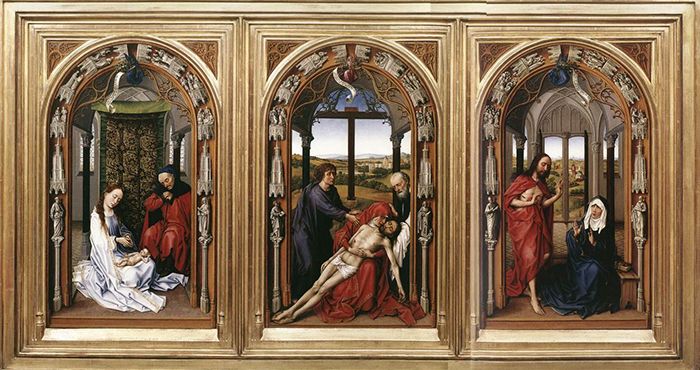
Miraflores Altarpiece (Triptych of the Virgin)
According to a source that cites the monastery's registry of documents, King Juan II of Castile donated this painting, by "Master Rogel," to the Carthusian charterhouse of Miraflores, near Burgos, Spain, in 1445. This makes it one of the most securely attributed of Rogier's existing works and demonstrates the international scope of his patronage. The three panels of the altarpiece feature, on the left, the birth of Christ, with Mary and Joseph, in the center, a Pietà in which Mary mourns the dead Christ, and on the right, Christ appearing to Mary after his resurrection (which is depicted in the background landscape), thereby forming a chronological account of significant moments in Mary's life. The banderoles held by angels floating above each scene describe the Virgin receiving a crown for her virtues. Each panel is framed by a painted round archway featuring fictive Gothic sculptural decorations that narrate additional moments of both Jesus' and Mary's life. As in his Descent from the Cross of 1430-35, Van der Weyden's placement of religious scenes in clearly defined interior spaces gives the sense of the figures being on a stage. The front edge of each panel features a step that seems almost to project toward the viewer, a device that art historian Jeffrey Chipps Smith suggests increases "the viewer's proximity to, and potential for imaginatively entering into, the divine stage."
The detailed scriptural program is appropriate for the altarpiece's location in a convent; King Juan II may have also commissioned it as a memorial for his wife and chosen the Marian theme as a tribute to her. Juan's daughter, Isabella I of Castile, probably commissioned a later, slightly smaller copy of the altarpiece - once considered the original - and bequeathed it to the Capilla Real in Granada, Spain, her burial site. Technical study by Maryan Ainsworth at the Metropolitan Museum has now conclusively attributed this version to Juan de Flandes, one of Isabella's court artists, who trained in Bruges.
The Miraflores Altarpiece is exemplary of Van der Weyden's style in details like the symbolic use of color in Mary's robes, where the white, red, and blue represent her purity, compassion and suffering, and faith, respectively. The tension between surface and depth is also characteristic, as is the play with trompe-l'oeil and "real" elements. In this period the artist also developed somewhat lighter, more delicate figures and greater simplification of their features.
Oil on oak panel - Gemäldegalerie, Berlin
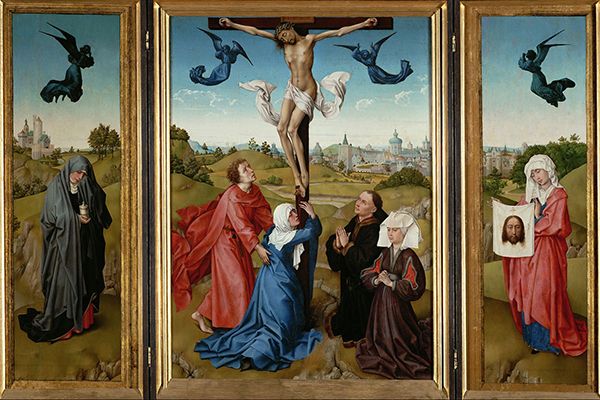
Crucifixion Triptych
The Crucifixion Triptych was probably originally painted on a single panel, with painted trompe-l'oeil frames around each section, and only later cut into three separate pieces. The painted frames are still partially visible around the two side panels. The central panel depicts the Crucifixion, with Mary and Saint John at the left, and the painting's donors at the right, separated only slightly from the main scene by a fissure in the earth. Scholars have suggested that this may be the first time in European painting that donors were placed in such close and virtually undifferentiated proximity to sacred figures. The left panel features Mary Magdalene, who carries a jar of ointment, and the right panel depicts Saint Veronica, who holds up the cloth that she used to wipe the face of the suffering Christ, and which still bears his image. Above the scene, against the blue sky, are four darkly colored, grieving angels.
As was typical of early Netherlandish religious painting, the landscape setting, with its verdant, softly rolling hills, resembles Northern Europe more than the environs of Jerusalem, where the Crucifixion is said to have occurred in the biblical narrative. The city in the background does, however, feature several onion-dome shaped towers among other typically northern building styles, lending a degree of exoticism to the setting. In this way, viewers could more easily envision themselves within the biblical scene represented, and more easily identify with the suffering of the figures. Once again, the focus of this work remains on the intensity of the figures' emotions: the two Marys weep with grief, Saint John is open-mouthed in shock and horror, and the two donors along with Saint Veronica are deeply absorbed in pious worship, whether outwardly or inwardly focused.
Oil on panel - Kunsthistorisches Museum, Vienna
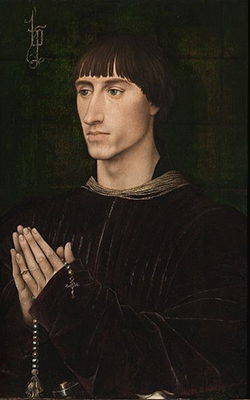
Philippe de Croÿ
An inscription and coat of arms on the reverse of this panel identify the sitter as Philippe de Croÿ (1434-1482), a member of the court of Philip the Good, Duke of Burgundy. He held several noble titles, including Lord of Sempy, Lord of Quiévrain, and Count of Chimay, and while there is little agreement over the interpretation of the monogram in the upper left of this image, it probably incorporates some or most of the letters of his name, or of the title Sempy. He is portrayed in prayer, holding a rosary, with the round hilt of a sword or dagger at his waist just visible at the bottom of the image. His pose indicates that this panel was half of a devotional diptych; he was most likely facing an image of the Virgin and Child, although again, there is disagreement over the identity of the companion panel (it may have been the version at the Huntington Library, Art Museum, and Botanical Gardens, San Marino, CA, or a different, lost, version).
This work exemplifies the highly refined style of court portraiture in which Van der Weyden specialized. The artist seems to have captured a faithful likeness of the sitter, but at the same time he has simplified and probably slightly elongated his features to make them more elegant. The fingers are very slender and not quite anatomically accurate (with the left thumb, for example, in strict profile), and the planes and volumes of his face are perfectly smooth and regular. Even his hair falls in precisely measured strips framing his face. The image also displays Van der Weyden's characteristic exploration of illusionistic conventions. The dagger hilt seems almost to protrude into the viewer's space, and suggests that the image continues below the frame, while the background - which initially appears to be a uniform, abstract color, in keeping with earlier styles of portraiture - is actually a fabric backdrop, with creases from having been folded becoming visible on careful inspection.
Oil on oak panel - Koninklijk Museum voor Schone Kunsten, Antwerp
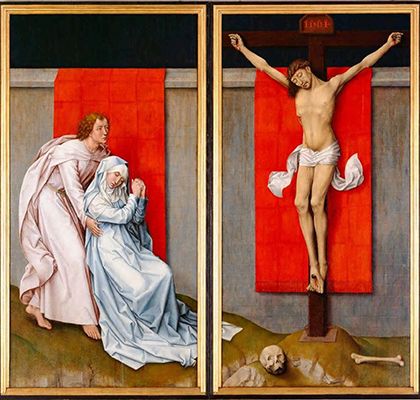
Crucifixion Diptych
This large, starkly dramatic work picks up many of the themes and approaches that Van der Weyden used throughout his career, giving equal weight to Christ's suffering and to the anguish of the witnesses to his death. The scene is set before a blank stone wall over which are draped two bright red cloths of honor, below a dark blue-black sky. In the left panel, a swooning Virgin Mary is supported by Saint John the Evangelist, both weeping and both dressed in unusually pale robes. In the right panel, Christ hangs heavily from the cross, the blood running down his forehead echoed by the tears of Mary and John. Despite the shallow space and limited setting, the skull and bone on the ground mark the site as Golgotha, or Calvary, where Christ was crucified, and where Adam, the first man, is said to have been buried, while the dark sky corresponds to the biblical description of the moment of Christ's death.
Van der Weyden's Crucifixion Diptych was made toward the end of his life, and may have been the last major work he painted. While the Philadelphia Museum dates it c. 1460, Dirk de Vos suggests an even later date, around 1463-64.
The original configuration of these two panels - which were certainly paired, as the continuation of Mary's robe from the left to the right panel clearly indicates - has been the subject of research and debate. The asymmetry of the composition differs from Rogier's other works, suggesting that they were not designed as a diptych, but were part of a multi-panel altarpiece. Technical examination and research by Christopher D. M. Atkins and Mark Tucker suggests that they served as the central outer two of four shutters covering a carved and painted wooden altarpiece. This placement helps to explain Rogier's highly simplified composition, as such outward-facing covers often featured figures in shallow, niche-like spaces, although his choice of a Crucifixion scene is unconventional. The extreme simplicity of Van der Weyden's design might indicate that the altarpiece was commissioned for a monastery; it would in any case have been a major project, one of the largest sculpted and painted examples of the period.
Oil on oak panels - The Philadelphia Museum of Art
Biography of Rogier van der Weyden
Childhood and Early Training
Roger (or Rogier) de la Pasture was born in Tournai, a town ruled by the French king but surrounded by territory controlled by the dukes of Burgundy, and now part of Belgium. His father Henri de la Pasture was a successful master cutler, part of Tournai's thriving industry of knife production, and his mother was demoiselle Agnès de Waterlos (or Watrelos). When he later moved to Brussels, he translated his name to the Flemish Rogier van der Weyden, and because of the numerous variants of his name in different documents - as well as the loss of documents and art over the course of time - much of his biography is uncertain and has long been subject to debate.
In the mid-1420s, Van der Weyden began his training as an artist by entering the workshop of Robert Campin, one of the most prominent artists in Tournai and dean of the painters' guild. Van der Weyden probably worked as Campin's assistant for several years before he was officially registered as an apprentice in 1427, an event that likely occurred (as scholar Dirk de Vos proposes) because of new regulations in the Tournai painters' guild that required artists to be officially registered as apprentices before they could become independent practitioners.
It is possible that Van der Weyden also gained a university education, as on November 17, 1426 he was honored by the city of Tournai as "Maistre (Master) Rogier de la Pasture." The title "master" was granted only rarely to artists, indicating not that they had completed their apprenticeship, but rather that they had achieved some other distinction, which is not clearly defined but may have reflected university studies. The sophistication of his compositions and iconography might also indicate that he gained an academic title.
In 1426, he married Elisabeth Goffaert, the daughter of a Brussels shoemaker. The couple went on to have four children: son Cornelis (b. 1427) who became a Carthusian monk; daughter Margaretha (b. 1432); son Pieter (b. 1437) who went on to become a painter; and son Jan (b. 1438), who became a goldsmith.
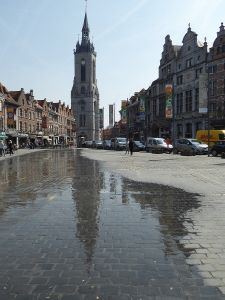
For much of the 1420s, Tournai experienced political and social upheaval, as power shifted between civic government, the French king, and the Burgundian dukes. Although Van der Weyden seems not to have been present at the sale of his father's house on his death in 1426, Dirk de Vos notes that it is nonetheless likely he was in Tournai throughout this period.
Van der Weyden became an independent master of the Tournai guild on August 1, 1432, having completed the requisite four years as a registered apprentice. He was also probably prompted by his master Robert Campin being sanctioned by the guild and his workshop forbidden for a time from taking on new commissions. Two small panels picturing the Virgin and Child in a Niche (c. 1425-30, Museo Thyssen-Bornemizsa, Madrid) and Saint George and the Dragon (c. 1425-30, National Gallery, Washington) are among the earliest works that may be attributed to Rogier, made while he was still in Campin's workshop. He continued to produce paintings in Tournai, including the celebrated Descent from the Cross (c. 1430-35, Museo del Prado, Madrid), and also polychromed sculptures and painted architectural elements for churches.
From Campin, Van der Weyden learned skills in the detailed realism seen in his earliest paintings. Both artists were interested in meticulous observation and in finding a balance between surfaces, volumes, and pictorial space, but stylistic distinctions are complicated by the collective nature of workshop practice, and by an ongoing lack of agreement among art historians over the constitution of Campin's oeuvre, and whether it can be equated with the output of an artist sometimes designated as the "Master of Flémalle."
During his time in Tournai, Van der Weyden probably also met painter Jan van Eyck, who visited the city and attended a reception held by the painters' guild in 1427, possibly as the guest of honor. As two of the most celebrated artists of their time, they must have known and appreciated each other's work throughout their careers.
Mature Period
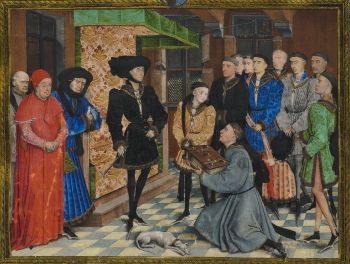
By late 1435, Van der Weyden had moved to Brussels, the new capital of the Burgundian state. He was likely drawn there by a special commission he received to paint four large-scale works in the Brussels City Hall. From then on, aside from a few return visits to Tournai, Van der Weyden's principal residence and workshop was in Brussels, on the "Golden Street" near Coudenberg Palace, the residence of the Duke of Burgundy. In March 1436, he was mentioned as the "Painter to the City of Brussels," a position that seems to have been created especially for him around the time of his move. It is at this time that he adopted the Flemish version of his name. His Brussels workshop was large, and he likely had several assistants there, including his son Pieter (who took over the workshop when his father died) and his nephew Louis le Duc.
The commission for the City Hall consisted of four huge paintings that combined measured some 65 feet (20 meters) wide. The scenes depicted the Legends of Trajan and Herkinbald, historical examples of the administration of justice, and were placed in the "Golden Chamber" of the City Hall. Numerous commentators, including Albrecht Dürer and Giorgio Vasari, praised the panels' skill, and they are the only works the artist is known to have signed. Unfortunately, the building and its contents were destroyed in the bombardment of Brussels in 1695, during the Nine Years' War between France and a group of European powers, although a partial copy in tapestry of the works (made in the 1450s and now in the historical museum in Bern, Switzerland) retains some sense of their content and style. Rogier's work on these panels must have occupied much of his time in the 1440s; only about ten other known surviving works date to this decade, although his workshop assistants probably produced others. Thanks to his growing wealth and status, he was able to give to the poor, donate a large altarpiece to the Carthusian monastery at Scheut, outside Brussels, and hold an administrative position for a time at a charitable foundation.
Late Period
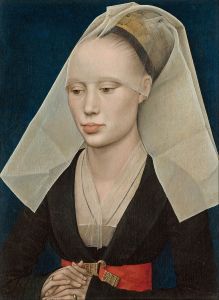
Documents suggest that in the Holy Year of 1450 declared by Pope Nicholas V (the same year that his daughter Margaret passed away), Van der Weyden traveled through Italy to make a pilgrimage to Rome. Along the way he encountered Italian artists and patrons, including the Este family of Ferrara and the Medici family of Florence, both of whom commissioned works from him. In June 1455 he received another important commission, for a triptych for the high altar of a church in Cambrai, a town south of Tournai. Despite a number of documentary details, the subject of the paintings is not known, and they cannot be connected with any currently known works. Most of his portraits date to this later period, and often take the form of a devotional diptych - a format he is credited with inventing - consisting of the patron facing a depiction of the Virgin and Child. He continued to work on a variety of projects, from polychroming sculptures to advising the Duke of Burgundy, and his renown continued to grow. This is demonstrated by such examples as the request in about 1460 by Bianca Maria Visconti, Duchess of Milan, to have her court painter go to Brussels to apprentice with Van der Weyden, which he accepted.
Van der Weyden died on June 18, 1464 in Brussels and was buried in the Chapel of Saint Catherine in the Cathedral of Saint Michael and Saint Gudule. The epitaph on his gravestone described him as "Master Rogier, the famous painter... So skilled were you at rendering the shape of things, Brussels mourns over your death..." and the painters' guilds of both Brussels and Tournai held memorial services for him.
The Legacy of Rogier van der Weyden
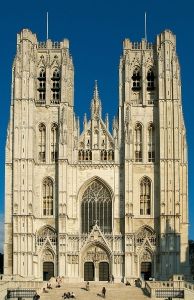
Rogier van der Weyden was one of the most influential artists of his time, along with his master, Robert Campin, and Jan van Eyck. These three painters shaped Northern Renaissance art most notably through the close observation and meticulously detailed representation of human figures and their surroundings. "In Flanders," Michelangelo is reported to have commented of his predecessors, "they paint with a view to external exactness... They paint fabric and masonry, the green grass of the fields, the shadow of trees, and rivers and bridges..." This attention to external appearances also heighted the realism of their works and amplified viewers' emotional responses to it.
Van der Weyden's compositions and style held great influence over successive generations of Flemish painters, including Petrus Christus, Dieric Bouts, Hugo van der Goes, and Hans Memling. His direct legacy was partly the result of his large and busy workshop, in which he trained other artists (most of them unknown) and developed drawings and model books that were reused to produce new paintings. While the only documented apprentice was the court painter to the Duchess of Milan, Zanetto Bugatto, Memling must also have spent time in Van der Weyden's workshop. Memling adapted many of Van der Weyden's compositions into his own interpretations, and his idealized, graceful figures, and dignified portraits also appear to draw inspiration from Van der Weyden's work. Study of the underdrawings in Memling's early work has revealed that he initially approached drawing in a similar manner to Van der Weyden. Memling also became well known for devotional diptychs that placed the praying patron alongside the image of the Virgin and Child.
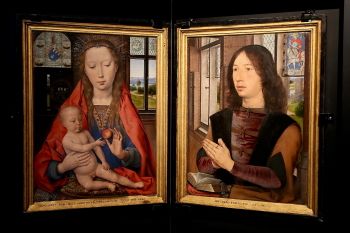
Van der Weyden's influence also reached further, to Italy, Spain, Germany, and France. German painter and engraver Martin Schongauer was inspired by Van der Weyden's compositions and figure types in the later 15th century, and Dürer sought to view his works during a trip through the Netherlands in 1520-21. Van der Weyden's innovative iconographic motifs, from Mary holding the Christ Child or mourning his death to the depiction of patrons in direct contact with sacred figures, were widely copied and emulated by later artists.
Van der Weyden remains a reference point for contemporary artists such as Bill Viola, who has cited the Descent from the Cross as a source for his own work in video. Viola's 2003 exhibition The Passions focused on the depiction of emotions through expression and gesture and included video portrait diptychs that clearly recall Van der Weyden's work. Viola's use of figures that initially appear to be still photographs but are in fact recorded in very slow motion also seems to echo Van der Weyden's exploration of the boundaries between painted images, sculpture, and staged tableaux vivants. Other contemporary artists who draw inspiration from Old Master paintings and similarly explore realism and the boundaries between two-dimensional and three-dimensional art include Titus Kaphar, who often adds to or cuts through the surface of his paintings, and Kehinde Wiley, some of whose paintings emulate the work of Northern Renaissance artists.
Influences and Connections

-
![Jan van Eyck]() Jan van Eyck
Jan van Eyck -
![Fra Angelico]() Fra Angelico
Fra Angelico - Robert Campin
- Gentile da Fabriano
-
![Renaissance]() Renaissance
Renaissance - Flemish Primitives
-
![Hans Memling]() Hans Memling
Hans Memling - Zanetto Bugatto
- Martin Schongauer
- Louis le Duc
- Vranck van der Stockt
Useful Resources on Rogier van der Weyden
- Van Der WeydenOur PickBy Lorne Campbell
- Rogier van der Weyden and the kingdoms of the Iberian PeninsulaBy Lorne Campbell and Carmen García-Frías Checa
- Rogier Van Der Weyden and SpainBy Lorne Campbell and Jose Juan Perez Preciado
- Early Netherlandish Painting: From Rogier Van Der Weyden to Gerard David (Studies in Medieval and Early Renaissance Art History)By Otto Pacht
- The Master of Flémalle and Rogier van der Weyden 1st EditionOur PickBy Stephan Kemperdinck and Jochen Sander
- Rogier Van Der Weyden: The Complete Works First EditionOur PickBy Dirk De Vos
- Rogier Van Der Weyden: Masters of Dutch ArtOur PickBy Stephan Kemperdick
- Flemish Primitives I: Master of Flemalle & Rogier van der Weyden Groups (Catalogue of Early Netherlandish Painting: Royal Museums of Fine Arts of Belgium)By C. Stroo
 Ask The Art Story AI
Ask The Art Story AI








